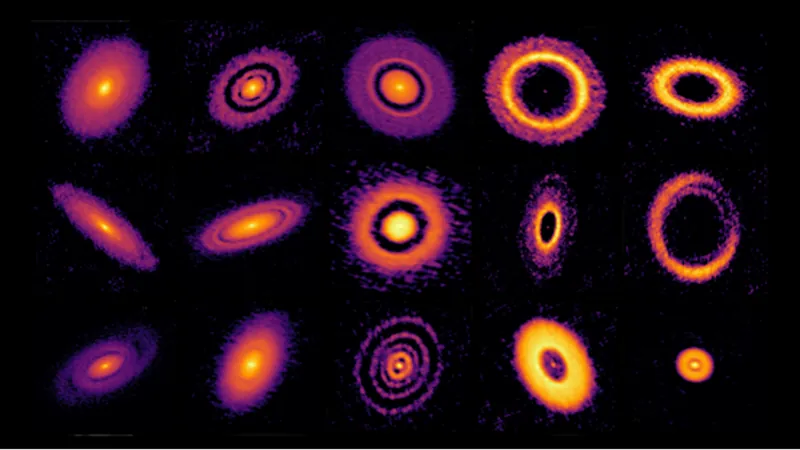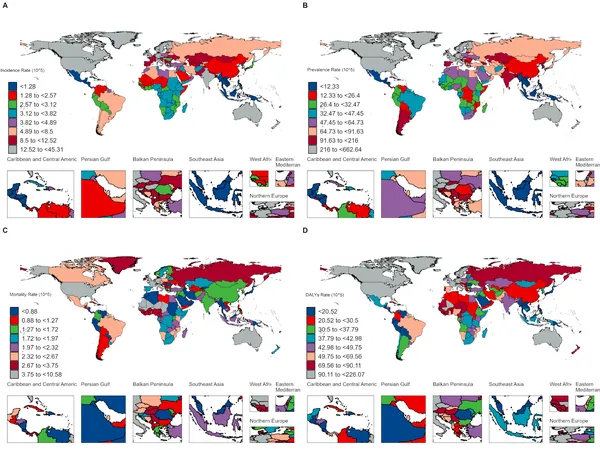
Revolutionary Insights: How Planets Are Shaping Their Own Birthplaces
2025-05-07
Author: Jia
A groundbreaking study is reshaping our understanding of planetary formation, revealing how planets might not just form but also sculpt their own environments. This new model, created by the ODISEA team, combines cutting-edge observations from ALMA and advanced simulations.
Unveiling Cosmic Mysteries: The ALMA Breakthrough
In 2014, ALMA (Atacama Large Millimeter/submillimeter Array) unveiled a mesmerizing image of the star HL Tau, showcasing intricate rings and gaps in a protoplanetary disk around a young star. This unexpected discovery led astronomers to delve deeper into the mechanisms behind the formation of these complex structures.
The Case for Planet-Driven Structures
Fast forward to 2018, the DSHARP survey revealed that such features were not isolated to HL Tau but prevalent in many protoplanetary disks. This revelation sparked intense debate among scientists regarding the potential role of forming planets in creating these features. The new research led by Santiago Orcajo from Argentina's Instituto de Astrofísica de La Plata provides substantial evidence supporting the idea that planets are key players in sculpting their birthplaces.
Five Stages of Planet Formation
The research introduces a compelling five-stage model for the evolution of protoplanetary disks. Each stage highlights how planets interact with their surroundings, from minimal structure in the very young disks to distinct gaps and rings formed as protoplanets grow and exert gravitational influence.
The Dynamic Dance of Giants
As giant planets form, they dramatically alter the dynamics of the surrounding disk, creating gaps that lead to the accumulation of dust. The study explains that these formations are not just passive elements but active indicators of the planet formation process, reshaping how we view the cosmos.
Innovative Tools for Discovery
Utilizing simulations alongside real ALMA data, Orcajo and his team successfully simulated each of the proposed evolutionary stages. Their findings shed light on how these planetary structures evolve over time, confirming long-held theories about their origins. "By observing these structures, we are witnessing planet formation in action," noted Antonio Hales, an ALMA astronomer.
Big Questions Remain
While the findings are revolutionary, they also invite further inquiry into the rapid formation of massive planets far from their stars. Continued exploration could pave the way for detecting smaller, rocky planets in less luminous disks, enhancing our understanding of planetary systems like ours.
A Collaborative Effort of Young Minds
The research is a collective effort by a talented group from the Instituto de Astrofísica de La Plata, the YEMS Millennium Nucleus in Chile, and several renowned universities. Their groundbreaking work has been published in the prestigious Astrophysical Journal Letters, marking a significant contribution to the field of astrophysics.
Closing Thoughts: A New Era in Astronomy
The implications of these findings extend beyond theoretical work; they provide a foundation for future astronomical observations. As we enhance our technology and understanding of the universe, the secrets of planet formation and the dynamic interactions within protoplanetary disks will unfold before our eyes.

 Brasil (PT)
Brasil (PT)
 Canada (EN)
Canada (EN)
 Chile (ES)
Chile (ES)
 Česko (CS)
Česko (CS)
 대한민국 (KO)
대한민국 (KO)
 España (ES)
España (ES)
 France (FR)
France (FR)
 Hong Kong (EN)
Hong Kong (EN)
 Italia (IT)
Italia (IT)
 日本 (JA)
日本 (JA)
 Magyarország (HU)
Magyarország (HU)
 Norge (NO)
Norge (NO)
 Polska (PL)
Polska (PL)
 Schweiz (DE)
Schweiz (DE)
 Singapore (EN)
Singapore (EN)
 Sverige (SV)
Sverige (SV)
 Suomi (FI)
Suomi (FI)
 Türkiye (TR)
Türkiye (TR)
 الإمارات العربية المتحدة (AR)
الإمارات العربية المتحدة (AR)